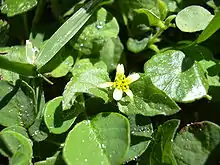Calyptocarpus
Calyptocarpus is a genus of flowering plants in the daisy family, Asteraceae.[3][4]
| Calyptocarpus | |
|---|---|
 | |
| Calyptocarpus vialis | |
| Scientific classification | |
| Kingdom: | Plantae |
| Clade: | Tracheophytes |
| Clade: | Angiosperms |
| Clade: | Eudicots |
| Clade: | Asterids |
| Order: | Asterales |
| Family: | Asteraceae |
| Tribe: | Heliantheae |
| Genus: | Calyptocarpus Less.[1] |
| Type species | |
| Calyptocarpus vialis Less. | |
| Synonyms[2] | |
| |
The name is derived from the Greek kalypto ("covered or hidden") and karpos ("fruit").[1] Species are distributed in the southern United States and Latin America.[1]
These are perennial herbs with decumbent to prostrate stems up to 30 centimeters long. The oppositely arranged leaves have blades of various shapes with toothed edges. Flower heads are solitary in the leaf axils. Each has 3 to 8 light yellow ray florets and several yellow disc florets. The fruit is a flat cypsela with a pappus of 2 or more awns.[1]
There are 2[1][5] to 6[6] species accepted in the genus.
- Calyptocarpus biaristatus - Brazil, Paraguay, Uruguay, Argentina
- Calyptocarpus burchellii - southeastern Brazil
- Calyptocarpus vialis – straggler daisy, horseherb, hierba del caballo, lawnflower,[7] creeping Cinderella-weed[8] - Texas, Louisiana, Central America, Venezuela; naturalized in Taiwan, Australia, Hawaii, parts of United States
- Calyptocarpus wendlandii - Central America, southern Mexico
References
- "Calyptocarpus Lessing, Syn. Gen. Compos. 221. 1832". Flora of North America. eFloras.org. Retrieved 2013-10-30.
- "Flann, C (ed) 2009+ Global Compositae Checklist". Archived from the original on 2014-11-11. Retrieved 2014-11-11.
- Lessing, Christian Friedrich. 1832. Synopsis generum compositarum earumque dispositionis novae tentamen, monographis multarum Capensium interjectis 221. in Latin
- Tropicos, Calyptocarpus Less.
- Nesom, G. L. (2011). Is Calyptocarpus vialis (Asteraceae) native or introduced in Texas? Phytoneuron 31, 1-7.
- Calyptocarpus. The Plant List.
- Calyptocarpus vialis. Lady Bird Johnson Wildflower Center. University of Texas, Austin.
- "Calyptocarpus vialis". Germplasm Resources Information Network (GRIN). Agricultural Research Service (ARS), United States Department of Agriculture (USDA). Retrieved 25 January 2018.
![]() Media related to Calyptocarpus at Wikimedia Commons
Media related to Calyptocarpus at Wikimedia Commons
![]() Data related to Calyptocarpus at Wikispecies
Data related to Calyptocarpus at Wikispecies